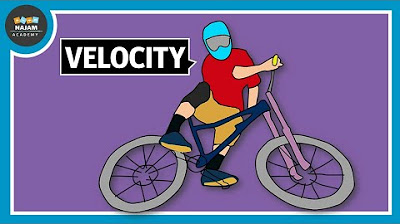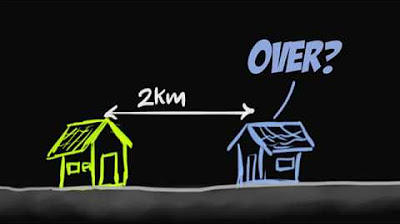What is Velocity? - Full Concept of Velocity - Physics | Infinity Learn
TLDRThe video script discusses the concepts of speed and velocity, emphasizing their differences. Speed is a scalar quantity that measures the distance covered in a unit of time without regard to direction, while velocity is a vector quantity that includes both speed and direction. The script uses examples to illustrate how average speed is calculated as total distance divided by total time, and average velocity is displacement divided by time. It highlights that even if a race car completes a race at high speed, the average velocity is zero due to the starting and ending points being the same, whereas the last-place finisher also has an average velocity of zero for the same reason.
Takeaways
- 📏 Speed is a scalar quantity representing the distance covered in a given time frame, without specifying direction.
- 🕒 The formula for speed is the distance traveled divided by the time taken to cover that distance.
- 📍 Displacement differs from distance in that it includes direction, making it a vector quantity.
- 🔄 Velocity is the combination of speed and direction, making it a vector quantity that describes motion.
- 🧭 To calculate average speed, divide the total distance traveled by the total time taken, regardless of path.
- 🏁 Average velocity considers only the starting and ending points, and is calculated as displacement over time.
- 📌 In the context of circular motion, like a race track, the average velocity can be zero even if the speed is high, due to zero displacement.
- 🛤️ The unit of measurement for both speed and velocity in the International System of Units (SI) is meters per second.
- 🚗 When discussing motion, it's important to distinguish between stating speed (scalar) and velocity (vector), as they convey different information.
- 📖 Understanding the difference between speed and velocity is crucial for accurately analyzing and describing motion in various scenarios.
- 📊 In physics, scalar quantities have only magnitude, while vector quantities have both magnitude and direction, influencing the analysis of motion.
Q & A
What is the definition of speed?
-Speed is the distance covered in a given amount of time, representing the rate at which an object moves without considering the direction of motion.
How can you calculate the distance covered by an object given its speed and the time taken?
-You can calculate the distance covered by multiplying the speed of the object by the time it has been moving. For example, if an object travels at 50 meters per second for one minute (60 seconds), the distance covered would be 50 * 60 = 3000 meters.
Why does speed not provide information about the direction of motion?
-Speed is a scalar quantity, which means it only has magnitude and does not include any information about the direction of motion. It tells us how fast an object is moving but not in which direction.
What is the difference between distance and displacement?
-Distance is the total length of the path traveled by an object, while displacement is the straight-line distance between the starting and ending points, including the direction of motion.
What is velocity and how does it differ from speed?
-Velocity is the speed of an object in a specific direction. Unlike speed, which is a scalar quantity, velocity is a vector quantity, meaning it has both magnitude and direction.
How is velocity measured?
-Velocity is measured in meters per second (m/s), which is the SI unit of measurement for velocity. This unit indicates the distance an object travels in one second, including the direction of motion.
What is average velocity and how is it calculated?
-Average velocity is the overall speed of an object over a certain time period, taking into account the direction of motion. It is calculated by dividing the total displacement by the total time taken.
What is the average velocity of an object that returns to its starting point?
-The average velocity of an object that returns to its starting point is zero, because the displacement, which is the straight-line distance with direction from the start to the end point, is zero.
In a Formula 1 race, if a car completes a 300 km race and finishes at the same point where it started, what is the car's average velocity?
-The car's average velocity in this scenario would be zero meters per second, because the displacement, which is the distance with direction from the start to the end point, is zero since the car returned to the starting point.
How does the average velocity relate to the path taken by an object?
-Average velocity depends only on the start and end points of the motion, without considering the actual path taken. It is concerned with the overall change in position and direction over the time interval, not the specific route or distance traveled.
What is the significance of understanding the difference between speed and velocity in physics?
-Understanding the difference between speed and velocity is crucial in physics because it allows for accurate analysis and prediction of motion. Speed provides information about how fast an object is moving, while velocity provides essential details about the object's rate of motion and its direction, which are vital for calculating displacement, understanding motion dynamics, and solving various physical problems.
Outlines
🏃♂️ Understanding Speed and Velocity
This paragraph explains the concepts of speed and velocity, emphasizing the difference between the two. Speed is defined as the distance covered in a unit of time without considering direction, making it a scalar quantity. An example is given where traveling at 50 meters per second for a minute covers 3000 meters, but does not indicate direction. Velocity, on the other hand, is speed with a specified direction, making it a vector quantity. The paragraph further clarifies that while speed only concerns the magnitude of movement, velocity accounts for both magnitude and direction. It introduces the concept of displacement, which is distance with direction, and contrasts it with distance. The unit of measurement for both speed and velocity is 'meters per second', as per the International System of Units (SI). The distinction between scalar and vector quantities is reiterated, with speed being scalar and velocity being vector.
🏎️ Calculating Average Velocity
This paragraph delves into the concept of average velocity, using practical examples to illustrate the calculation. It begins by explaining that average velocity is determined by the start and end points, irrespective of the path taken, and is calculated as displacement over time. An example is provided where a 20-kilometer journey is taken on a 50-kilometer path due to road works, resulting in an average speed of 25 kilometers per hour, but an average velocity of 10 kilometers per hour since the displacement is only 20 kilometers. The paragraph continues with a scenario of a Formula 1 race, where despite completing the race, the average velocity of the winner and the last-place finisher is zero, because displacement is zero (starting and ending at the same point). This highlights the difference between speed, which can be nonzero, and average velocity, which accounts for direction and can be zero even if speed is not. The summary emphasizes the importance of understanding the difference between average speed, which is the total distance covered divided by total time, and average velocity, which is displacement divided by time, especially in scenarios where the starting and ending points are the same.
Mindmap
Keywords
💡Speed
💡Distance
💡Direction
💡Velocity
💡Displacement
💡Scalar Quantity
💡Vector Quantity
💡Average Speed
💡Average Velocity
💡International System of Units (SI)
💡Formula 1 Race
Highlights
Speed is defined as the distance covered in a given amount of time.
Speed is a scalar quantity, meaning it only has magnitude and no direction.
The formula for calculating the distance covered is speed multiplied by time.
An example given shows that traveling at 50 meters per second for one minute covers a distance of 3000 meters.
Displacement differs from distance in that it includes direction.
Velocity is the combination of speed and direction, making it a vector quantity.
To determine where an object ends up, velocity must be used instead of speed.
The unit of measurement for both speed and velocity is meters per second.
Average speed is calculated by dividing the total distance covered by the total time taken.
Average velocity, on the other hand, is calculated by dividing displacement by time.
In a scenario where the start and end points are the same, the average velocity is zero.
For a race where the finish line is the same as the start point, the displacement is zero, resulting in an average velocity of zero.
Even if a car travels at 55 miles per hour, without specifying the direction, it is only stating its speed, not its velocity.
The International System of Units (SI) uses meters per second as the standard unit for both speed and velocity.
Understanding the difference between speed and velocity is crucial for accurately describing motion.
In physics, scalar quantities have only magnitude, while vector quantities include both magnitude and direction.
A real-world example of calculating average velocity involves considering the displacement from the start to the end point.
In a Formula 1 race, despite the distance covered, the average velocity of a car that finishes where it started is zero.
For any race where the start and finish line are identical, the average velocity, not speed, will be zero due to zero displacement.
Transcripts
Browse More Related Video

What is Velocity? Physics

11 - What is Definition of Average Speed & Velocity in Physics? (Speed Formula & Velocity Formula)

Average speed & velocity (with examples)

Distance vs. Displacement & Speed vs. Velocity | Kinematics Explained

What Are Speed and Velocity? | Physics in Motion

Displacement and Velocity - How is it different from Distance and Speed? | Physics
5.0 / 5 (0 votes)
Thanks for rating: